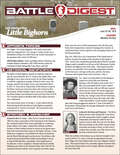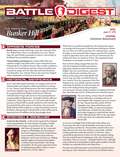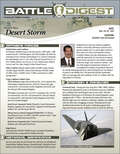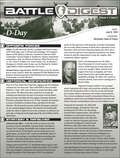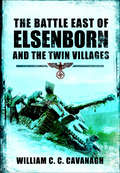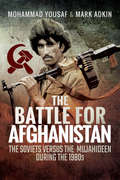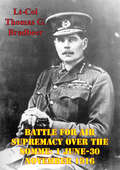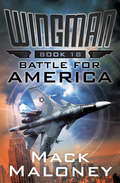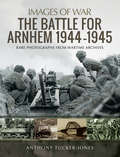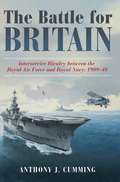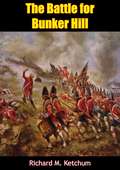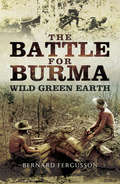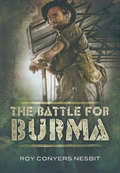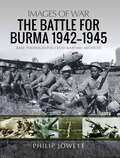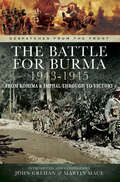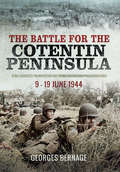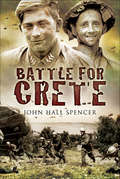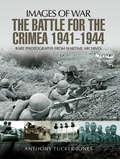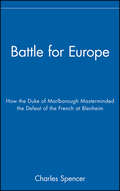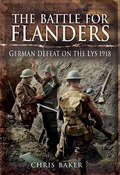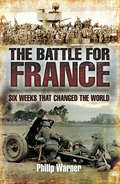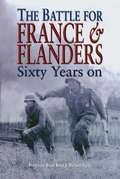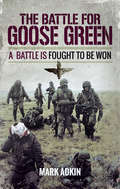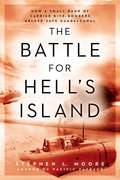- Table View
- List View
Battle Digest: Little Bighorn (Battle Digest Series)
by Michael E. Haskew Christopher J. Petty<p>A concise history of Custer’s Last Stand with maps, facts, historical significance, and more. The battle of Little Bighorn, despite its relatively small size, was the worst defeat for the U.S. Army in the Indian Wars. Although it was a clear tactical victory for the Plains Indians, it also would be a significant strategic setback for their cause. The outrage resulting from the Indian victory only intensified efforts by the U.S. Army and its Department of the Missouri to pacify the Native Americans and return those who resisted to their reservations. Within months of their victory at the Little Bighorn, the Plains Indians were defeated in the Great Sioux War of 1876–1877 and their lands in the Black Hills of the Dakota Territory were confiscated.<p> <p>Learn why the controversial George A. Custer rushed into battle against his Indian opponents on that fateful day, and how Brigadier General Terry’s failure to synchronize his forces contributed to “Custer’s Last Stand.”<p> <p>The Battle Digest summary includes all the key aspects of the campaign and battle, including maps, images, and lessons learned.<p>
Battle Digest: Bunker Hill
by Christopher J. Petty<p>The Battle Digest summary includes all the key aspects of the campaign and battle, including maps, images, and lessons learned.<p> <p>In the weeks following the skirmishes at Lexington and Concord, Colonial militia and volunteers rallied around Boston to besiege Lt. Gen. Thomas Gage’s British garrison. But when reinforcements arrived from England, Gage devised a plan to regain the initiative by occupying Dorchester Heights south of town. When the Colonials heard of Gage’s plan, however, they preempted him by occupying different high ground ? the heights of Bunker Hill near Charlestown.<p> <p>When Gage awoke on 17 June to the sight of rebel positions on Breed’s Hill, he quickly attacked in what would be the first pitched battle of the American Revolution. The misnamed Battle of Bunker Hill would prove a costly and shocking victory for the British, while giving the Colonials faith in their militias and an important boost of confidence for the long struggle ahead.<p>
Battle Digest: Desert Storm (Battle Digest Series)
by Christopher J. Petty<p>A concise guide to the American-led coalition’s speedy defeat of Saddam Hussein in 1991, with maps, facts, historical significance, and more. Just two years after the end of Iraq’s war with Iran, an emboldened Iraqi dictator, Saddam Hussein, invaded Kuwait. Operation Desert Storm was the final phase of the U.S.-led Coalition’s effort to expel Saddam’s forces from his southern neighbor’s borders. In less than 100 hours of joint air and ground combat, the U.S. and its allies would not only triumph, but also demonstrate to the world the superiority of a new breed of weapons. The battle also had the unintended effect of renewing a pride and confidence in the U.S. military after the long shadow of Vietnam.<p> <p>Learn how America built a coalition of nations to go to war, and how Gen. Norman Schwarzkopf used maneuver and deception to create one of the most lopsided victories in the history of warfare.<p> <p>The Battle Digest summary includes all the key aspects of the campaign and battle, including maps, images, and lessons learned.<p>
Battle Digest: D-Day (Battle Digest Series)
by Christopher J. Petty Flint Whitlock<p>A concise guide to the Normandy invasion with facts, maps, historical significance, strategies, and more.<p> <p>Operation Overlord, commonly referred to as “D-Day,” was the Allied invasion to secure a foothold in northern France to enable the final offensive into Germany. The Normandy invasion would be the largest combined air-sea assault landing in history. This massive feat would finally enable the Allies to deploy forces on the continent, of sufficient size and scale, to bring about the beginning of the end of Hitler and his Third Reich.<p> <p>Learn how General Eisenhower managed to attack German weakness with Allied strength as well as how intelligence and deception were crucial to the outcome.<p> <p>The Battle Digest summary includes all the key aspects of the campaign and battle, including maps, images, and lessons learned.<p>
The Battle East of Elsenborn and the Twin Villages
by William C. CavanaghThe Battle East of Elsenborn closely examines the role of Oberstgruppenfuhrer Joseph 'Sepp' Dietrich's Sixth Panzer Army in the massive German winter counteroffensive. Hitler had tasked Dietrich with making the main effort east of the Elsenborn Ridge and against the positions of the US 99th Infantry Division. Hitler's plan was to reach deep into Allied-held territory and seize the vital port of Antwerp. In the event this daring and desperate counterattack failed but it was a close run thing. Credit for the outcome must ultimately go to the American soldiers who, some new to combat and others battle-hardened, fought valiantly to blunt the German advance and ultimately bring it to a halt just east of Elsenborn. The book also studies the actions of six individuals who earned the Congressional Medal of Honor, their nation's highest bravery award. It tells of the courageous story of men who believed in their heritage, and who, through their heroic teamwork and dedication, stopped the main effort of the German Sixth Army. American veterans who participated in this battle remember the events, even after sixty years, as only yesterday. They also remember their compatriots and friends who died in this battle. The author, has probed into every possible source for factual information. He has studied official after-action reports, histories and unit reports of organizations involved in the battle. In addition, he has conducted an extensive program of individual contacts, not only with the US Army participants, local villages and resistance fighters, but also with German commanders at various levels in the 3 divisions involved. Such an ample and widespread research effort has enabled the author to separate fact from fiction.The author William C. C. Cavanagh acted as principal research assistant to the late Charles B. MacDonald, himself a veteran and former Company Commander in the 2d Infantry Division. Having lived in the Ardennes area for thirteen years, he knows the battlefields intimately and his book A Tour of the Bulge Battlefield was first published by Pen & Sword Books in 2001.
The Battle for Afghanistan: The Soviets Versus the Majahideen During the 1980s
by Mohammad Yousaf Mark AdkinThis is the story of the defeat of Soviet Russia's forces in Afghanistan by a guerrilla force known as the Mujahideen, heavily backed by Pakistan and the USA. The Mujahideen paved the way for the Taliban regime, to exist having all but defeated the Russian Army in the late 80's.The author, Brigadier Mohammad Yousaf, was head of the Afghan Bureau of Pakistan's Inter-Service Intelligence and as such was effectively the Mujahideen's commander-in-chief. He controlled the flow of thousands of tons of arms across Pakistan and into its occupied neighbor, arms that were bought with CIA and Saudi Arabian funds from the USA. One of the Mujahideen's close allies was none other than Osama Bin Laden.This compelling book was put together with great skill the by military historian, Mark Adkin in conjunction with Brigadier Mohammad Yousaf and is essential reading for anyone interested in the truth behind the Afghanistan War which led to the conditions that exist there today.A hardback edition of this book was published by Casemate in 2001 under the title Afghanistan: The Bear Trap.
Battle For Air Supremacy Over The Somme: 1 June-30 November 1916
by Lt-Col Thomas G. BradbeerMuch has been written about the Battle of the Somme. From July through late November 1916, British, French, and German armies fought one of the costliest battles of the twentieth century. Well over a million casualties and only a few miles of ground gained by the Allies were the result when the battle ended. Little, however, has been written about the second battle which occurred simultaneously, this one in the skies above the Somme, where for the first time in the history of warfare a deliberate attempt was made to control the sky. The British Royal Flying Corps, under the resolute command of General Sir Hugh Trenchard, fought to gain air supremacy from the German Air Service. Trenchard believed that the best way to support the ground force was to dominate and control the sky above the battlefield. This air campaign was critical because of its impact on the doctrine and theory of air warfare which followed it.This study examines the efforts of the Royal Flying Corps to gain air supremacy against the German Air Service before and during the Battle of the Somme.
Battle for America (Wingman #18)
by Mack MaloneyAn ace fighter pilot aims to save a shattered America from Russian invasion in this new Wingman novel from “the best high-action thriller writer out there”(Jon Land). Former US Air Force major Hawk Hunter and his band of patriotic ex-military men have fought tirelessly to reunite their fractured nation after the Russian nuclear sneak attack that put a devastating end to World War III. Now, returning from a space odyssey that began with the diversion of a comet headed for Earth, Hunter finds a 60,000-man Russian army occupying New York City, ready to invade the rest of America. Equally alarming are reports claiming that Hawk’s former girlfriend, Dominique, is living with the head of the Russian secret police in a Manhattan penthouse. Buzzing through the city’s skyscraper canyons in a tiny STOL Highlander and glimpsing the enemy invaders’ massive weaponry for himself, Hawk realizes he’s up against the greatest danger his homeland has ever faced, even with the help of Captain “Bull” Dozer and his team of ex-Marines. But with the woman and the country he loves in dire peril, threatened by a mysterious convoy of Russian superships, the Wingman will apply all his aviation prowess and strategic ingenuity to devise a plan to launch the fiercest, most crucial battle for America yet, no matter the risks. Filled with fast-paced, furious action and a wide range of aircraft and military hardware that will fascinate techno-thriller fans, Battle for America brings back favorite characters from earlier books in the series and delivers a riveting story that reveals new insight on America’s most enigmatic hero: the Wingman.
The Battle for Arnhem 1944–1945: Rare Photographs From Wartime Archives (Images of War)
by Anthony Tucker-JonesA photographic history of WWII&’s Operation Market Garden and the Allies&’ quest for the famed &“Bridge Too Far.&” Operation Market Garden, September 1944, the Netherlands. Three parachute drops and one armored charge. The prize was the last bridge at Arnhem over the Neder Rijn. Taken intact, it would provide the Allies with a backdoor into Germany—the famous &“Bridge Too Far.&” This was one of the most audacious and imaginative operations of the war, and it failed. Anthony Tucker-Jones&’s photographic history, with a sequence of almost 200 archive photographs accompanied by a detailed narrative, describes the landing of British and American parachutists and glider troops. At the same time, British tanks spearheaded a sixty-mile dash along &“Hell&’s Highway&” to link up with the lightly armed and heavily outnumbered airborne forces. Most books about the resulting battle concentrate on the struggle at Arnhem and the heroism of the British 1st Airborne Division. This book puts that episode in its wider context. In particular it focuses on the efforts of the US 101st and 82nd airborne divisions to hold off counterattacks by German battlegroups during the tanks&’ advance. The photographs give a dramatic insight into all sides of a remarkable but ill-fated operation which has fascinated historians and been the subject of controversy ever since. They also portray, as only photographs can, the men who were involved and the places and conditions in which the fighting took place.
The Battle for Britain
by Anthony J. CummingThe book is a short review of British air and naval power from 1909 -1940 and represents an attack upon "independent” airpower. When Bleriot became the first man to fly the English Channel in a heavier-than-air flying machine in 1909, it seemed to mark the beginning of a fundamental decline in British attitudes towards maritime defense. Exploiting prevalent invasion paranoia, press baron, Lord Northcliffe invited distinguished writers such as William Le Queue and H G Wells to write articles on the theme "We are no longer an Island”. Bleriot’s exploit encouraged the politicians to reassess how Britain would be defended in the future. An important government committee heard evidence that led directly to the forming of the Royal Flying Corps - an organization that initially included army and naval wings. Superficially, the Royal Navy was moving from strength to strength as it expanded in the naval arms race with Germany. The service remained in high public esteem but a section of the ruling Liberal party wanted money diverted for welfare - a new and powerful competitor for funds. The Two-Power Standard was quietly dropped in 1909 and the astronomical costs of battleship building forced the Navy to look for cheaper substitutes such as submarines and aircraft. A forceful critic of naval expenditure, Winston S. Churchill fostered the early development of airpower when he became First Lord in 1911 and continued to do so when out of office. The German air raids of 1917 panicked the wartime government into making an ill-considered merger of naval and army air arms that supported imaginative but untried theories of airpower. In 1938, a later government submitted to the national psychosis of bombing by allowing the Royal Air Force to be the only service to rearm without regard to the nation’s ability to afford it. In 1940, the contribution of the Royal Navy was minimized as Churchill praised the RAF for saving the nation from invasion in the Battle of Britain. As a result the RAF’s story has achieved an iconic status that is part of British national identity. Consequently, more important operations including the Dunkirk evacuation; Battle of the Atlantic; Battle of Mers El Kebir and the naval operations against the Italian fleet have been underrated and misunderstood. This ultimate justification of independent airpower continues to undermine understandings of maritime defense and may have skewed US and UK defense policies in the wrong direction for decades.
The Battle for Bunker Hill
by Richard M. KetchumBoston, 1775: A town occupied by General Thomas Gage's redcoats and groaning with Tory refugees from the Massachusetts countryside. Besieged for two months by a rabble in arms, the British decided to break out of town. American spies discovered their plans, and on the night of June 16, 1775, a thousand rebels marched out onto Charlestown peninsula and began digging a redoubt (not on Bunker Hill, which they had been ordered to fortify, but on Breeds Hill, well within cannon shot of the British batteries and ships). At daybreak, HMS Lively began firing. It was the opening round of a battle that saw unbelievable heroism and tragic blunders on both sides (a battle that marked a point of no return for England and her colonies), the beginning of all-out war.
The Battle for Bunker Hill: The Battle For Bunker Hill
by Richard M. KetchumBoston, 1775: A town occupied by General Thomas Gage’s redcoats and groaning with Tory refugees from the Massachusetts countryside. Besieged for two months by a rabble in arms, the British decided to break out of town. American spies discovered their plans, and on the night of June 16, 1775, a thousand rebels marched out onto Charlestown peninsula and began digging a redoubt (not on Bunker Hill, which they had been ordered to fortify, but on Breeds Hill, well within cannon shot of the British batteries and ships). At daybreak, HMS Lively began firing. It was the opening round of a battle that saw unbelievable heroism and tragic blunders on both sides (a battle that marked a point of no return for England and her colonies), the beginning of all-out war.With impeccable scholarship, Richard M. Ketchum’s 1962 book describes the historic setting and importance of the battle, analysing the character and motives, as well as the many blunders, of responsible leaders on both sides. He gives a detailed and fascinating depiction of the battle, recapturing in graphic style each witness account.
The Battle for Burma: Wild Green Earth
by Bernard FergussonBernard Fergusson was one of Orde Wingate's Column Commanders in the heroic but battered Chindit expedition behind Japanese lines in Burma in 1943. By 1944 Wingate had persuaded Churchill and Roosevelt that a bigger force, on the same unorthodox lines, could make a strategic difference. Aged 32, Fergusson returned to Burma as part of this, as a Brigadier, leading the only Brigade in the new force which entered Burma on foot. It was one of four Brigades which established well-defended strongholds within Japanese-occupied Burma. Fergusson also reflects candidly, and often humorously, on different aspects of the campaign. These include the ingenuity and sheer courage of the US Army Air Force pilots who flew in supplies and evacuated wounded. One glider pilot whom Fergusson saw making a particularly bad landing turned out to be Jackie Coogan, child star of Chaplin's The Kid, and later known as Uncle Fenster of the Addams Family. In apparently light hearted, but often profound sections, he analyses the management of a large and diverse force, up against physical extremes far from normal amenities and command structures; the importance of maintaining morale and of medical management; and, not least, an immediate portrait of Wingate himself, whose death at a crucial stage of the campaign and the conflicting or at least confusing orders he left behind directly affected Fergusson's men and the fate of the campaign.The Wild Green Earth follows the author's account of the 1943 campaign, Beyond the Chindwin. Both were written with the events, and reactions even the smells fresh in the author's mind, and vividly but sensitively conveyed. The excitement of the narrative remains today. And the reflections are timeless, fascinating for those with an interest in leadership and motivation as much as for readers of military history.
The Battle for Burma
by Roy Conyers NesbitThe struggle of British, Commonwealth and American-Chinese troops against the Japanese in Burma was one of the decisive campaigns of the Second World War. British India was threatened by the Japanese advance, the fate of the British Empire in the East hung in the balance. The tropical climate dense malarial jungle infested with vermin and swept by monsoon rains made the fighting, for both sides, a remarkable feat of arms. Yet the war in Burma rarely receives the attention it deserves. Roy C. Nesbit, in this highly illustrated account, traces the entire course of the campaign. In vivid detail he describes the British retreat and humiliation at the hands of the Japanese invaders in 1942. The Japanese were fanatical and trained in jungle warfare, well-equipped and backed with an overwhelming air power. The Allied response was to build up their forces on a massive scale eventually over 1,300,000 personnel were involved and to train them to fight in the jungle conditions. Their counter-offensive, launched in 1944, culminated in the battles at Imphal and Kohima which turned the course of the conflict, and the reconquest of Burma was achieved just before the atom bomb was dropped.
The Battle for Burma, 1942–1945: Rare Photographs From Wartime Archives (Images of War)
by Philip JowettThe battle for Burma during the Second World War was of vital importance to the Allies and the Japanese. The Allies fought to protect British India and force the Japanese out of Burma; the Japanese fought to defend the north-west flank of their newly conquered empire and aimed to strike at India where anti-British feeling was growing stronger. Yet the massive military efforts mounted by both sides during four years of war are often overshadowed by the campaigns in Europe, North Africa, the Pacific and China. Philip Jowett, using over 200 wartime photographs, many of them not published before, retells the story of the war in Burma in vivid detail, illustrating each phase of the fighting and showing all the forces involved – British, American, Chinese, Indian, Burmese as well as Japanese. His book is a fascinating introduction to one of the most extreme, but least reported, struggles of the entire war. The narrative and the striking photographs carry the reader through each of the major phases of the conflict, from the humiliation of the initial British defeat in 1942 and retreat into India and their faltering attempts to recover the initiative from 1943, to the famous Chindit raids behind Japanese lines, the Japanese offensive of 1944 and their disastrous retreat and ultimate defeat.
The Battle for Burma, 1943–1945: From Kohima & Imphal Through to Victory
by John GrehanDespatches in this volume include that on operations in Burma and North-East India between November 1943 and June 1944, by General Sir George J. Giffard; the despatch on operations in Assam and Burma between June 1944 June and November 1944, by General Sir George J. Giffard, Commander-in-Chief; the despatch on Naval operations in the Ramree Island area (Burma) in January and February 1945 by Vice-Admiral Sir Arthur J. Power, Commander-in-Chief, East Indies Station; and the despatch on operations in Burma between November 1944 and August 1945 by Lieutenant-General Sir Oliver Leese.This unique collection of original documents will prove to be an invaluable resource for historians, students and all those interested in what was one of the most significant periods in British military history.
The Battle for Cotentin Peninsula: 9–19 June 1944
by Georges BernageIn June 1944, the Americans left the Sainte-Mre-Eglise and Utah Beach bridgehead and crossed the Merderet river to the Chausse de la Fiere, taking Picauville on 10 June. Their advance was slowed following the failure of the 90th Infantry Division, but they were able to take Pont-l'Abbe on 12 June and Saint-Sauveur-le-Vicomte 16 June. Two days later they cut the Cotentin peninsula at Barneville, before heading north towards Cherbourg.As well as authentic eyewitness testimony, the book also acts as a field guide, including maps and both contemporary and modern photographs.
Battle for Crete
by John Hall SpencerThis WW2 military history “combin[es] a look at the background to the battle . . . and the ground level memories of the participants with great skill.” (History of War.org)After two years’ extensive research, John Hall Spencer has written a thorough account of the political and military background to the German invasion of Crete and the bitter fighting that followed the first airborne assault on an island in history. Battle for Crete tells of confused negotiations between the British and Greek governments; the misunderstandings between Winston Churchill’s War Cabinet and commanders in the field; the near capture of the King of Greece; the lack of preparation by the defenders and the suppression of a critical post-battle report by General Wavell.There are vivid eyewitness accounts of the fighting both during the invasion and the subsequent campaign and ultimate retreat and evacuation. The Royal Navy and Royal Air Force’s contribution is well documented, as are the roles of the German air force, in this “close run” campaign fought with aggression by both sides.
The Battle for Crimea, 1941–1944 (Images of War)
by Anthony Tucker-JonesThe selection of over 150 rare wartime photographs in this volume in Pen & Swords Images of War series offers a graphic visual record of the dramatic and bloody battles fought for the Crimea during the Second World War. They show every grim aspect of the fighting and reflect in many ways the ruthless character of the struggle across the entire Eastern Front. The German-led Axis forces took eight months to conquer the Crimea in 1941-2 the Soviet defenders of the fortified city-port of Sevastopol held out against repeated assaults for 250 days. In 1944, after the course of the war had turned against the Wehrmacht and their allies, the city was liberated by the Red Army, but only after over 120,000 Axis troops had been evacuated across the Black Sea. Naval operations involving the Soviet Black Sea Fleet and the Romanian Royal Navy are covered in the book, as is the battle in the air between the Luftwaffe and the Red Air Force. But perhaps the most memorable photographs give an insight into the ordinary soldiers experience of the fighting and show the enormous material damage the conflict left behind.
Battle for Europe: How the Duke of Marlborough Masterminded the Defeat of the French at Blenheim
by Charles SpencerA &“wondrously enthralling&” history of the bloody battle that ended Louis XIV&’s dream of European domination (The Times, UK). In 1704, the armies of French King Louis XIV were poised to extend the French frontiers to the Rhine and install a French prince on the Spanish throne. But as French forces marched toward Vienna, allied armies commanded by John Churchill, Duke of Marlborough, and Prince Eugene of Savoy set out to oppose them. The two forces clashed at Blenheim, in Bavaria, and the previously undefeated French were routed. Based on original sources, this &“thoughtful, interesting, and well-written&” narrative brings the battle to life, capturing the deliberations of kings as well as the experiences of ordinary soldiers (The Sunday Telegraph, UK).
The Battle for Flanders: German Defeat on the Lys 1918
by Chris BakerThe Battle of the Lys, fought in April 1918, was critical for the Allies and for Germany. The outcome of the Great War hung in the balance. After the successful German offensive on the Somme, their breakthrough on the Lys threatened Ypres and the British hold on Flanders and brought them close to victory on the Western Front. The Allied line was broken it was only saved by improvisation and great gallantry—and the German onslaught tested Allied cooperation under the newly appointed Generalissimo Ferdinand Foch to the limit. Yet, as Chris Baker shows in this compelling account, the declining force of the German attack revealed deficiencies in material, organization and morale that led to their ultimate defeat.
The Battle for France: Six Weeks That Changed The World
by Philip WarnerAfter the long winter of the Phoney War the invasion of the Low Countries and France by Hitlers rampaging armies threw the World into crisis. Chamberlains Government fell, Churchill became Prime Minister. France was humiliated, the British Expeditionary Force was only saved by the miracle of Dunkirk but many men and huge amounts of equipment were lost to the Blitzkrieg. England trembled but the invasion never came.Philip Warner graphically recounts the momentous events of that terrible period thanks to his painstaking research and skillful writing. He demonstrates how the under trained and ill-equipped British forces gallantly but futilely resisted the German land and air onslaught. He emphasizes the understated contribution of the French. This book provides a fresh and invaluable explanation of the military and political events of that extraordinary campaign, which continued on after Dunkirk.
The Battle for France & Flanders: Sixty Years On (Military History Ser.)
by Brian Bond Michael TaylorThe Fall of France in 1940 has been well chronicled but numerous misconceptions remain.This fascinating and thought-provoking collection of essays on wide-ranging issues covering the politics and fighting on land, sea and in the air will be greatly welcomed by academics and military history enthusiasts.Topics covered include the preparations of the BEF, the failure of allied counter attacks, the air war, the Royal Navys's role in the campaign, the influence of the Battle on British military doctrine and the repercussions from the British, French and German angles.
The Battle for Goose Green: A Battle is Fought to be Won (Cassell Military Paperbacks Series)
by Mark Adkin&“Probably the best and most detailed description of a key battle in the 1982 Falklands War . . . an excellent and fast paced narrative.&” —Michael McCarthy, historical battlefield guide This book tells the story of the battle for Goose Green—the first crucial clash of the Falklands War—through the eyes of the commanders, both British and Argentine, from brigadier to corporal. It follows in detail, with the aid of maps, the fourteen hours of vicious infantry as both sides struggled for the tiny settlement of Goose Green. The book explains how 2 Para came close to failure as the battalion fought over open ground, in daylight, without adequate fire support against prepared positions. Controversial questions—such as: Was it an unnecessary battle? Why did London overrule the brigadier commander&’s reluctance to attack? Did Col. Jones&’s solo charge, which won him the Victoria Cross, decide the issue?—are discussed frankly. The author, himself a former infantry officer, has had the full support of the Parachute Regiment, and has assembled the views and comments of over forty-five veterans of all ranks who fought there. &“The Falklands War showed British military personnel at their best and most innovative under the most testing of conditions, and the Battle of Goose Green was one of the classic actions . . . The author has made an impressive job of reviewing the important factors, the events and decisions that led to the battle.&” —Firetrench &“This brought home to me how the infantry fight and how the British Paratrooper has gained a worldwide reputation for being one of the best fighting men around. A superb read.&” —Army Rumour Service
The Battle for Hell's Island
by Stephen L. MooreFrom the author of Pacific Payback comes the gripping true story of the Cactus Air Force and how this rugged crew of Dive-Bombers helped save Guadalcanal and won the war.November 1942: Japanese and American forces have been fighting for control of Guadalcanal, a small but pivotal island in Japan's expansion through the South Pacific. Both sides have endured months of grueling battle under the worst circumstances: hellish jungles, meager rations, and tropical diseases, which have taken a severe mental and physical toll on the combatants. The Japanese call Guadalcanal Jigoku no Jima--Hell's Island.Amid a seeming stalemate, a small group of U.S. Navy dive bombers are called upon to help determine the island's fate. The men have until recently been serving in their respective squadrons aboard the USS Lexington and the USS Yorktown, fighting in the thick of the Pacific War's aerial battles. Their skills have been honed to a fine edge, even as injury and death inexorably have depleted their ranks. When their carriers are lost, many of the men end up on the USS Enterprise. Battle damage to that carrier then forces them from their home at sea to operating from Henderson Field, a small dirt-and-gravel airstrip on Guadalcanal.With some Marine and Army Air Force planes, they help form the Cactus Air Force, a motley assemblage of fliers tasked with holding the line while making dangerous flights from their jungle airfield. Pounded by daily Japanese air assaults, nightly warship bombardments, and sniper attacks from the jungle, pilots and gunners rarely last more than a few weeks before succumbing to tropical ailments, injury, exhaustion, and death. But when the Japanese launch a final offensive to take the island once and for all, these dive-bomber jocks answer the call of duty--and try to perform miracles in turning back an enemy warship armada, a host of fighter planes, and a convoy of troop transports.A remarkable story of grit, guts, and heroism, The Battle for Hell's Island reveals how command of the South Pacific, and the outcome of the Pacific War, depended on control of a single dirt airstrip--and the small group of battle-weary aviators sent to protect it with their lives.
